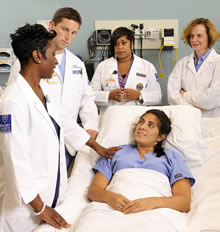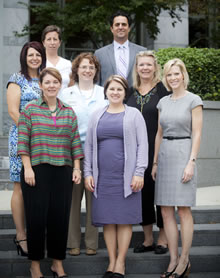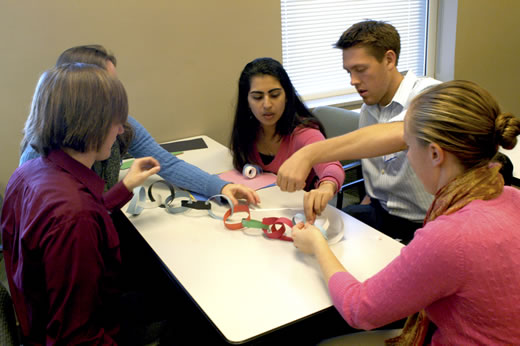From the day students enter the Emory DPT program, they are immersed in all things physical therapy. They study alongside other physical therapy students, attend lectures given by physical therapists and practice their new clinical skills under the guidance of physical therapists. Yet upon graduation, these newly minted DPTs will be expected to leave that physical therapy silo and interact seamlessly with members from various health care disciplines to form a cohesive unit dedicated to caring for the patient.
"Health care delivery is a team sport," says Bethany Robertson, clinical assistant professor in the Nell Hodgson Woodruff School of Nursing. "Doctors, nurses, physical therapists and others all train independently, but at the end of the day they have to all come together as a team to deliver the best possible care for the patient."
To prepare students for that day, Emory brings students from all the clinical health science disciplines together twice during their academic career for Interprofessional Team Training Days (ITTDs). Shortly after they begin their studies and again before they graduate, students from the programs of physical therapy, medicine, nursing, physician assistant, medical imaging and anesthesia assistant come together. The goal — to teach these future health care providers how to communicate efficiently and effectively within a team.
"We teach different communication strategies and skills through lectures and role-playing," says Beth Davis, assistant professor of rehabilitation medicine and a member of the Emory Interprofessional Team Training Planning Team. "For example, if you are not the team leader but you notice a problem, how do you make others on the team aware of it? How do you convey patient information efficiently? How can you be very succinct yet also courteous and respectful to others on the team?"
 | |
Interprofessional Team Training Days (ITTD) student participants |
These "soft" skills may seem unworthy of valuable class time, but in reality they can be as critical as "hard" clinical skills. "Just ask a clinician who has been practicing for 20 years," says Robertson. "They've likely seen that their individual clinical expertise is not enough — it's the entire interprofessional team that ensures the patient's outcome."
Indeed, a 1999 Institute of Medicine report, "To Err is Human," brought the importance of healthcare teamwork into the national spotlight. The report estimated that 44,000 to 98,000 Americans die in hospitals each year because of medical errors. For every mistake that ends in death, there are countless more with less severe outcomes. Many of these errors stemmed from a breakdown in communication somewhere along the care provider chain.
That report led to a push to improve the collaboration and communication within the health care team. As part of that push, the School of Nursing secured funding from the Robert Woods Johnson Foundation to mount an interprofessional collaboration. Robertson, who was co-PI for the foundation proposal, partnered with Douglas Ander, professor of Emergency Medicine and director of Emory's Center for Experiential Learning, to create the first ITTD. In 2007, 213 medical and nursing students participated in a curriculum based on TeamSTEPPS team-training protocol, a program developed by the Agency for Health Care Research and Quality and the Department of Defense, which aims to improve patient safety and improve communication and teamwork skills among health care professionals.
 | |
The Emory Interprofessional Team Training Planning Team, front row, l-r: Bethany Robertson ( Nursing), Carolyn Clevenger (Nursing), Beth Davis (Physical Therapy). Middle row, l-r: Kim Greenberg (Medical Imaging), Betsy Rothschild (Physician Assistant), Barbara Peck (Medical Imaging). Back row, l-r: Kate Woeber (Nursing), Douglas Ander (Medicine). Missing: Alyssa Bryant (Medicine), Ruth Sacco (Anesthesia Assistant) |
The program was so successful that they decided to include the other health professions programs, and in 2008 all the clinical health care disciplines began to participate. Each student attends a session early in their first year and again near their graduation.
The first session, held in the fall, is an introduction to the concept of team communication. "We start off talking about why communication and teamwork is important and the safety implications for patients," says Ander. "We also introduce each discipline.
Most students have no idea what other the other health specialties are and how they interact."
After the introductory lecture, students are broken into small groups of 10 students from various disciplines facilitated by two inter-disciplinary professionals. They start out with an ice-breaker exercise — making a paper chain out of construction paper as a team, first being able to use both arms and speak to each other and then using only one arm and not speaking to each other.
The students then participate in several role-playing scenarios, one involving patient care and one not.
"In our group, someone had to pretend to be stuck in traffic and late for an important conference, and someone else was the leader of the conference," says Jennifer Lee Ko, a second-year DPT student who participated last year. "The person stuck in traffic had to call the leader and they had a conversation. In another session we had to convey patient information over the phone to another team member. Some groups went back and forth with that a lot, but in the real world physicians don't have that much time to stay on the phone, so you have to say what you need to say very efficiently."
Students attend their second ITTD in the spring prior to graduation. "Students often come into the second session a lot more interested in the topic," says Ainsley Rossi, who facilitates the sessions. "In the first year, it's all very theoretical. But by their second session, they've been out on their clinical rotations, and they've seen how critical good communication really is. They may have even witnessed a communication breakdown and its repercussions."
The second session, again through lectures and role-plays, delves into the role of the team leader, conflict management and patient-centered care. "We set up a scenario where someone disagrees with the doctor and needs to speak out," says Ander. "The key to reducing medical errors is empowering everyone to speak and to be heard."
Jill Cannoy, DPT '12, found the session eye-opening. "It was interesting to see what the different professions would do in different settings, and it was particularly helpful to see that there is not necessarily one right answer," says Cannoy. "Rather, everyone can work togetherto resolve an issue."
The students aren't the only ones to benefit from the ITTDs. "Each time we run a session, we train our facilitators beforehand," says Davis. "I think those training sessions and the ITTDs strengthen their attitude toward team work. And they impart that to their students. This is critical for educators teaching students and clinicians working to improve patient care."
Rossi agrees. "At the training session we have to practice the skills ourselves," she says. "It's a chance to interact with other professionals whom I've not had a lot of interaction with. There were physicians role-playing as nurses and vice versa. It made us all aware that in terms of patient care, we must all be working together cooperatively and be less concerned about our specific title or position."
Are two days enough to teach students what they need to know about operating as part of a team? "Absolutely not!" says Robertson. "Teaching people how to function together as a team is hard work. There is a whole body of science around it. Like any other skill you have to learn, it takes time and practice. But this is a start. A very good start."

